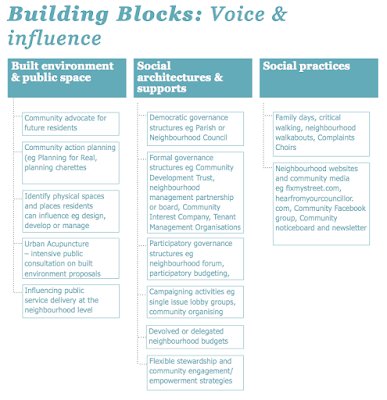Sustainability still is broadly examinedfrom the angle of environmental concerns. Nevertheless there is a growingawareness of social sustainability amongst urban planners and architects. The Young Foundation recentlypublished a report commissioned jointly by the Homes and Communities Agencyas part of Future Communitiesprogramme on the Design for Social Sustainability. On 55 pages, the reportprovides ‘a framework for creating thriving communities’. In the forewordBartlett Professor Peter Hallargues that under the scope of last summer’s riots in Great Britain we havefailed to create successful new communities within the existing fabric. Hefurther argues that “This study, which might have seemed peripheral andacademic, has become central and urgent. […] The lessons and the recommendations of this report are bound tohave a salience that its authors can never have imagined.” In relation to theongoing urbanization the report poses the question: how can we create newcommunities in new housing developments that will flourish and succeed longinto the future? In Europe 32 newtowns are being created across 11 countries. Of course, the posed questionshould not be only approached by Western cities. Some estimates suggest that inChina 100 new cities with a population more than 1 million will be created inthe next three years. For example, as part of the Expo 2010 resettlementprogramme PujangNew Town in Shanghai aims to house 500,000 new residents to create One City, NineTowns. Outside Seoul the Incheon Development Area will house 200,000 peopleby 2010, while in Delhi four new satellite cities are being created to dealwith overcrowding and to cater for India’s growing middle classes. It presentsand will present huge challenges for governments to provide decent andaffordable private and social housing in communities that are economically,environmentally AND socially sustainable. But this is not a new challenge. Manyprojects have been developed to design out crime, incorporating socialinfrastructures, considering the role local greenspaces play in wellbeing andso on. However, many of them have failed. Partly because putting into practicewhat is known is difficult, claims the report. Theoretically these approacheswork out, but practically every community is different and therefore socialsustainability cannot be prescribed in the same way as standards for environmentalsustainability. Hence, it iscrucial to incorporate the specific local conditions. However, the report arguesthat planning for social success and sustainability can prevent or at leastmitigate, the likelihood of future social problems, and in many cases,represents a fraction of the overall costs of development and long termmanagement. After arguing the undeniable, that social sustainability has a case,the report defines extensively the terminology. Subsequently the YoungFoundation tries to lift the debate out of the academic arena and developed aframework that contains four elements that are essential to build new sociallysustainable communities: amenities and social infrastructure, social andcultural life, voice and influence, can space to grow.
What follows are the lucid diagramsdescribing the four elements of the framework (All images © by The Young Foundation)



Although further research is needed in therealm of social sustainability, the Young Foundations framework might be a hugestep forward on this terrain. It suggests a structured procedure which referencingfor every urban planner, designer and policy maker, as these issues will be oneof the main challenges of this century.
Related to this and the potentialpreventions of future disasters like the recent riots read Technologyand Urban Warfare in the archive.



No comments:
Post a Comment